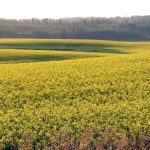Nope, no matter how often hail mows down your crop, it probably won’t be the weather that ultimately does in your operation. It likely won’t be poor markets, or changing consumer demands either. Odds are it won’t even be a health crisis, or disease in your crops, or the million and one other worst-case scenarios that hover over farming.
The single most likely reason your farm will fail is because your dreams are bigger than your cash reality.
At issue is the fact that, for many farmers — especially the youngest and most gung-ho — basic operating often takes a back seat to growth plans.
Read Also

Producers aren’t panicking over tariffs and trade threats
The Manitoba Canola Growers Association (MCGA) surveyed its members this spring to get a sense of how trade uncertainty was…
“Growth chokes the cash, and then you’re forced to liquidate
Live by the numbers
Your bottom line is your own bottom line. It isn’t any one else’s. It’s unique to your farm, and it means you need to make understanding your financial position a top priority, maybe your highest priority of all.
Guessing what you can afford — instead of actually knowing what you can pay — will get you into trouble very quickly. So will paying what someone else can afford instead of what makes sense for you.
When a great equipment deal or land price entices, our experts say, your first step should be to reach for a calculator.
Farming would be a whole lot easier if there was a simple set of rules that applied to everyone. However, given that every farm is different in size, structure, assets and liabilities, and every farmer is different in risk tolerance, business know-how, and production ability, there are few one-size-fits-all rules.
When it comes to accessible working
assets to gain that cash,” sums up Gordon Williams, an independent farm business management consultant at Cardston, Alta., and member of the Canadian Association of Farm Advisors (CAFA).
“I’ve seen some real tragedies,” Williams says. “The bottom line is that poor management of cash will kill your farm, and the even sadder thing is it will likely kill your marriage too.”
So, what can you do about it?
No one says you have to stop dreaming. Everybody needs goals. In fact, for most of us, our hopes for the future are what keep us persevering through the not-so-good times.
Instead, the advice from the people in the know is: keep dreaming, but manage your growth, know your numbers and don’t jump too fast.
capital — the cash you have on hand to cover operational expenses — farms tend to have far less than other businesses because of the low margins and high cash demands inherent to farming.
Williams recommends having the cash to cover six months of operating expenses and debt-servicing payments, and he cautions that you should start to anticipate trouble if your cash reserves are down in the three month range.
Wayne Evanisky, an account manager in agricultural services with TD Canada Trust in Saskatoon and another CAFA adviser, suggests another way of calculating your cash needs.
Bankers look for their farm clients to have working capital to get them from seeding through to harvest and sales, Evanisky says. “We like to see a ratio of current assets, which includes your cash and all dollars available to you in the next 12 months, to current liabilities, which are all the payments you’re going to be making in the next 12 months, of 1.75:1.”
Stick to a plan
Most farm business problems can be averted if you have a cash plan, says Williams. By that he means a fully thought-out, written strategy that details exactly what you can and can’t afford.
“Business and cash planning should be as important a part of your yearly planning as what you grow,” Williams says.
Evanisky agrees. “The biggest thing in any business — and farming isn’t any different — is to sit down and assess where you are, and then plan where you want to be, what you’re going to do, and how you’re going to get there,” he says. “You’ll figure out in a hurry whether it’s going to cash flow or not.”
The plan needs to map expenses and revenues. It also needs to outline resources, and to detail exactly what reserve funds you will have on hand at any time. It’s a great winter project — but it’s valuable no matter when you do it — and it’s a job that needs doing every single year.
Your cash plan must take into account both operations and proposed growth.
“The first priority… is to have enough cash to operate,” says Williams. “You need to be really careful that you’re not growing too fast to pay your bills.”
Secondly, you need to have enough cash to accommodate your growth strategy. As your farm grows and your expenses increase, you need to make sure you set aside an equally increasing portion of accessible cash.
Simply put, says Williams, if you don’t have the cash accessible to grow your farm, your farm can’t afford to grow.
3 Don’t get caught in the myth of “more”
“I’ve seen some (farming operations) succeed at growing quickly,” says Evanisky. “If you are a strong manager and you know the risks of the growth pattern you’re taking on, you may be able to balance the growth.”
“But,” Evanisky warns, “you really have to have a good understanding of how you’d be able to get out if something goes sideways.”
It’s common to say that many farmers’ greatest downfall is their tendency to focus on production management above business management. Still, even though we hear it all the time, it may be a thought that carries more wisdom than we expect.
Here’s the problem. According to a production mindset, if you don’t have enough cash to operate comfortably, you simply need to produce more. The bigger is better logic seems clear. Doubling production should double your dollars, right?
That’s wrong in most cases, our expert says, and here is why.
If it costs $25,000 to produce $50,000 amount of crop or product, what will it cost to produce $100,000?
The simplest math says it will cost $50,000 to produce that $100,000 in product. You might even argue that improved efficiencies (ie: equipment usage, bulk input purchases, etc.) should actually cut your costs under $50,000.
However, nothing happens in isolation. Producing double the crop is going to take double the time. To offset the increase in time, you’ll need to invest your farm’s operating cash in increasing its operational efficiency, which means bigger equipment, better technology, and more automation.
Out of necessity, the cost of producing your $100,000 quietly creeps up to $75,000, or it may even hit $100,000. Sure, your revenue may double, but your profits are swirling down the toilet and your business is now starved for cash.
As Evanisky reminds, “You don’t want more debt than your operation can handle.” He recommends a 0.5:1 ratio of debt to net worth, and says the maximum you’d want to consider would be a 1:1 ratio.
“When you get that high in debt, your risk has gone up tremendously (and) you’ve got a lot less room for error,” Evanisky says. “Any little blips — rates going up, a bad crop — can cause concern.”
Cash offers distinct advantages to those who have it in hand, says Williams. Your cash reserves shouldn’t sit quietly in a savings account, waiting to be spent in the typical ways and at the typical times on operating expenses.
Instead, if you use those reserves wisely, Williams says, you’ll find they stretch about 20 per cent further.
Take advantage of every discount. Pre-buy fertilizer. Buy in bulk. Start spending cash at off-peak times of the year. You’ll quickly find that you spend far more cash at the front end of the cycle, but the savings will be impressive.
Also use cash rather than credit. This may sound obvious, but we’ve become such a credit card society that many of us forget how deeply the credit companies gouge when it comes to interest payments.
Realistically, most farmers are not going to be investing their operating cash in non-farm investment opportunities, given that cash output is so constant in farming. “Managing surplus (operating) cash doesn’t seem to be much of a problem, since farmers rarely have too much of it floating around,” says Williams. However, if you want to hold onto cash reserves via investments, ensure your investment vehicle choice is flexible enough to allow you to pull the dollars easily and without penalty.
Get help
If you didn’t have the time to harvest a crop, the expertise to identify a new pest, or the knowledge to fix your tractor, you’d get
help. Moreover, you’d expect to pay for that help, knowing the cost is a necessary operational expense.
Why then is spending money on business-oriented support so much more difficult for farmers?
Farm business consultants tend to get called in when the operation is already in financial trouble, says Williams. “If (the farmer) sat down with a management team and created an overall strategy right at the very beginning, they’d be in a much better position for success.”CG
———
1
———
2
———
4
———
5














